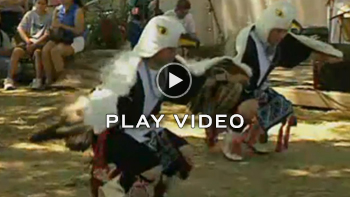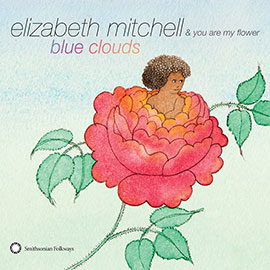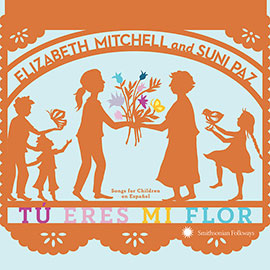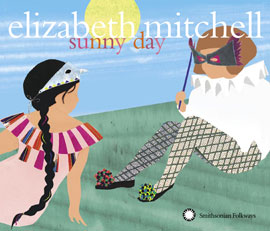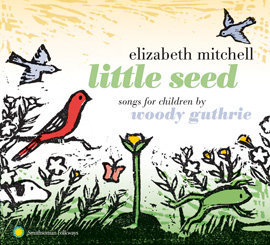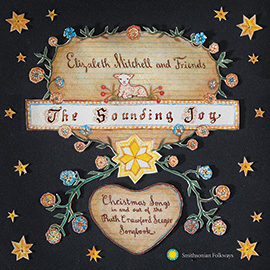Summary
Students will learn the process of telling a story through song, while learning basic musical skills like rhythm, beat, movement, dance, singing on pitch, and call-and-response format. The featured songs are “Froggie Went a Courtin,” “Arm and Arm,” and “The Little Bird,” from Elizabeth Mitchell’s album Blue Clouds.
Suggested Grade Levels: Pre-K, K-2
Country: United States
Region: Americas
Culture Group: American
Genre: Folk, Children’s Music
Instruments: Voice, Rhythm Sticks, and Clapping Hands
Language: English
Co-Curricular Areas: Science (Animals, Biology)
National Standards: 1, 2, 6, 8, 9
Prerequisites: None
Objectives:
- Practice keeping a steady beat and copying rhythm
- Learn Call and Response Format
- Gain an understanding of music and movement
- Connect song to story and story to song
- Exercise fine motor and phonics skill by writing and drawing about songs learned
- Create written stories and simple songs
Material:
- “Froggie Went A Courtin” from Blue Clouds by Elizabeth Mitchell
- “The Little Bird” from Blue Clouds by Elizabeth Mitchell
- “Arm in Arm” from Blue Clouds by Elizabeth Mitchell
- American Indian Eagle Dance video from Smithsonian Folkways
Lesson Segments:
- Froggie Went A Courtin – Movement, Rhythm and Beat (National Standards 1, 6, 8)
- Arm and Arm – The Octopus – Dance and Call and Response (National Standards 1, 6, 8, 9)
- The Little Bird – Instrumentation and Call and Response (National Standards 1, 2, 6)
Lesson Segment 1: Froggie Went A Courtin – Movement, Rhythm and Beat
- Animals, Story and Movement
- Ask the students what their favorite animal is. Invite individual students to demonstrate the movement of that particular animal.
- Tell the students about the story “Froggie Went A Courtin”
- It is an English language folk song – folk songs were among the original genres of songs in England.
- The song is said to have been written for courtship. Courtship is another word for dating.
- In this song, the courtship is between a Frog and a Mouse.
- Ask the students to listen to the song and try to remember all of the different animals and bugs that are mentioned in the song.
- After the students listen to the song, ask them what the different animals are: Frog, Mouse, Owl, Bat, Bumblebee, Rat, Moth, Goose, Ant. Discuss the different movements each animal makes – be sure to distinguish between each animal. For example, distinguish the difference between the flight patterns of an owl as opposed to that of a bat or a bumblebee.
- Listen to the song again. Whenever Elizabeth sings about a new animal, encourage the students to move the way that animal moves.
- Rhythm and Beat – The Heart Beat
- Explain to students that movement is an important part of song. In the past, dance and song were always connected together. In some cultures there is still rarely dancing without music, or music without dancing.
- Play the song again. This time, instead of having the students act as animals, have them march to the beat.
- Discuss with students the importance of beat and rhythm in music. It often helps to explain to the students that music has a heartbeat, much like people do.
- Then, draw a picture of four hearts in a row. Write a number one in the first heart, a number two in the second heart, a number three in the third heart, and a number four in the fourth heart.
- Play the song again. Point to the beats as they pass in the song. Have the students say the numbers of the beats as they pass.
- Start having the students clap along with the beat. If they are struggling with clapping have them continue to say the notes allowed or walk to the beat.
- Encourage the students to sing along to the chorus of the song as they clap. Listen for pitch accuracy. If the students are struggling with singing and clapping, have them start off by singing and then add the clapping or walking to the beat motions.
Extension: Depending on the skill level of the students, have them either draw or draw and write a caption for or a sentence about the story of “Froggie Went a Courtin.”
Assessment: Take note of each student’s ability to pay attention to the lesson and ability to stay on the beat. Give praise when warranted and/or discuss with the class ways to make the future lessons smoother and more productive.
Lesson Segment 2: Arm and Arm – The Octopus – Dance and Call and Response
- Animals in Dance and Song
- Discuss with students what they remember from the last lesson. Highlight the importance of dance and movement in song as well as reminding them of music’s “heartbeat.”
- Explain to students the historic importance of animals in dance and songs. In Indian culture, animals were often represented in dance and dance was often accompanied by song.
- Shows students part of the Smithsonian Folkways video of the Eagle dance.
- Ask them what animal the men in the video are representing.
- Tell students that we are now going to listen to the video “Arm and Arm.” Ask them to remember the kind of animal that is sung about in the song.
- Ask the students how many arms an octopus has. Once they correctly guess eight, ask them how many arms a child has. Then ask them how many students there would need to be to make the same number of arms as an octopus. (Four students)
- Have the students get into groups of four. When Elizabeth sings the chorus, “arm and arm and arm and arm,” demonstrate for the students how to “swing your partner” by linking arms and passing partners between the group of four.
- Sing along
- Perform “Arm and Arm” with the teacher singing the call with Elizabeth Mitchell and prompting the students to sing the response with the children on the track.
- If you are comfortable, sing without the track.
- Make sure that students sing in a bright head tone and encourage pitch accuracy.
- Have students dance and sing along with the track.
Extension: Have students chose other animals and sing the song “arm and arm,” replacing octopus with a different animals and “arm” with “wing,” “fin,” etc., if need be.
Assessment: Take note of each student’s ability to pay attention to the lesson, sing on pitch, and follow the call and response structure in order to know what elements to focus on subsequent lessons.
Lesson Segment 3: The Little Bird – Bird – Instrumentation and Call and Response
- Instrumentation
- Ask the students if they have ever played any instruments or if they have ever seen any instruments. Have them demonstrate with motions how to play the instruments.
- Play “The Little Bird” for the students. Ask them to try to figure out which instruments are played in the song. (Vocals, Glockenspiel, Percussion (rattle/shaker), Guitar)
- Play “The Little Bird” again. Point out the different instruments. It helps if you are able to hum what the instruments are playing, or clap what the percussion is doing.
- Show the students pictures of the instruments. Demonstrate to them how the instruments are played and have them imitate the motions of the various instruments throughout the song.
- Call and Response
- Sing along – perform “The Little Bird” with the teacher singing the call and prompting students to sing the response.
- Switch roles and play and song through again with students singing the call and the teacher singing the response.
- Watch to make sure the students stay on pitch and sing in a nice, bright head tone.
Extension: If you have hand rhythm instruments such as maracas, drums, shakers, rattlers, have the students shake or tap the instruments along with the percussion of the song.
Assessment: Take note of the student’s ability to pay attention to the lesson, clap the rhythm, follow call and answer, and stay on pitch in order to know what elements to focus on subsequent lessons.
Lesson Segment 4: Linking it All Together
Ask students to write their own song about their favorite animal. You can chose a melody from one of Elizabeth Mitchell’s songs, or you can be creative and invite the students to create their own melody. See if a few of the students will sing their songs for the class as a kind of “show and tell.” If students seem nervous, it might help for you to sing their song with them. Encourage the class to learn the song and sing along.
If students seem too nervous to sing in front of the class, see if they will write a few lines of a story. You can then turn the story into a song, or you can have them read the story out loud to the class.



